Haman Au-Cu-Ag Project
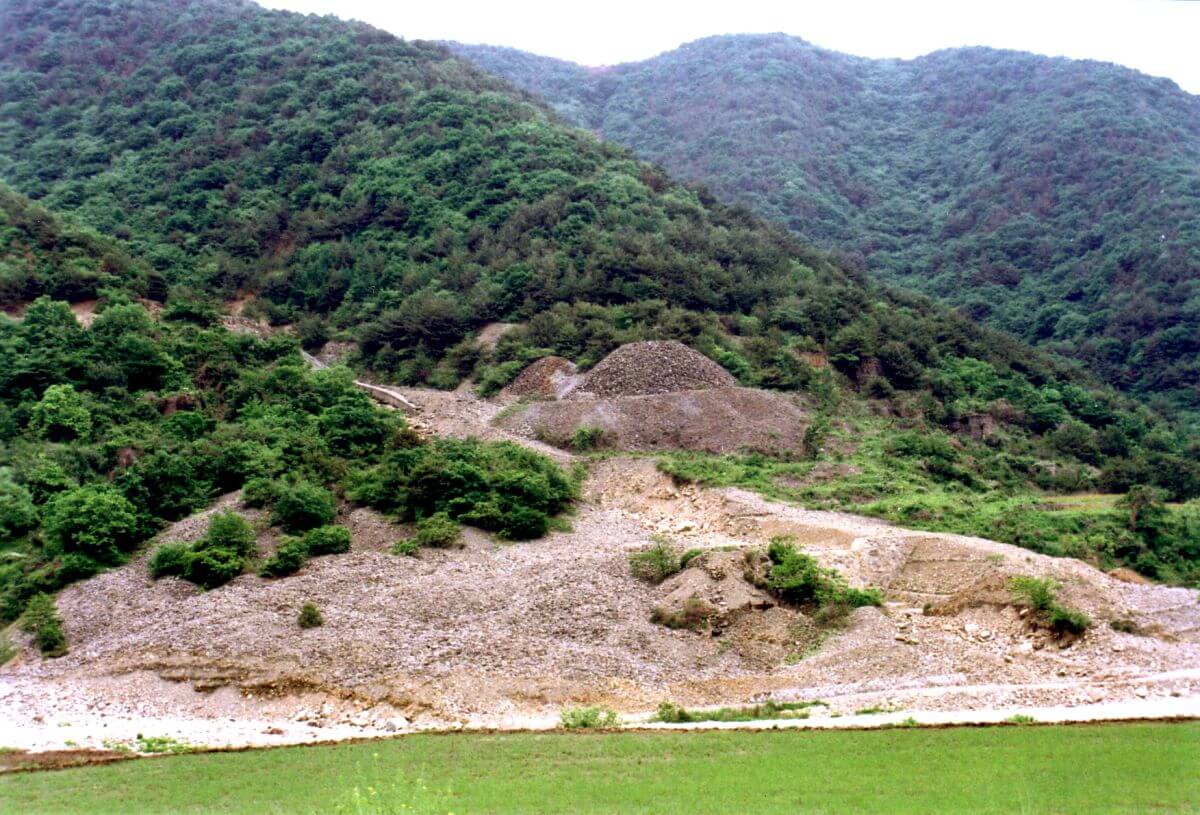
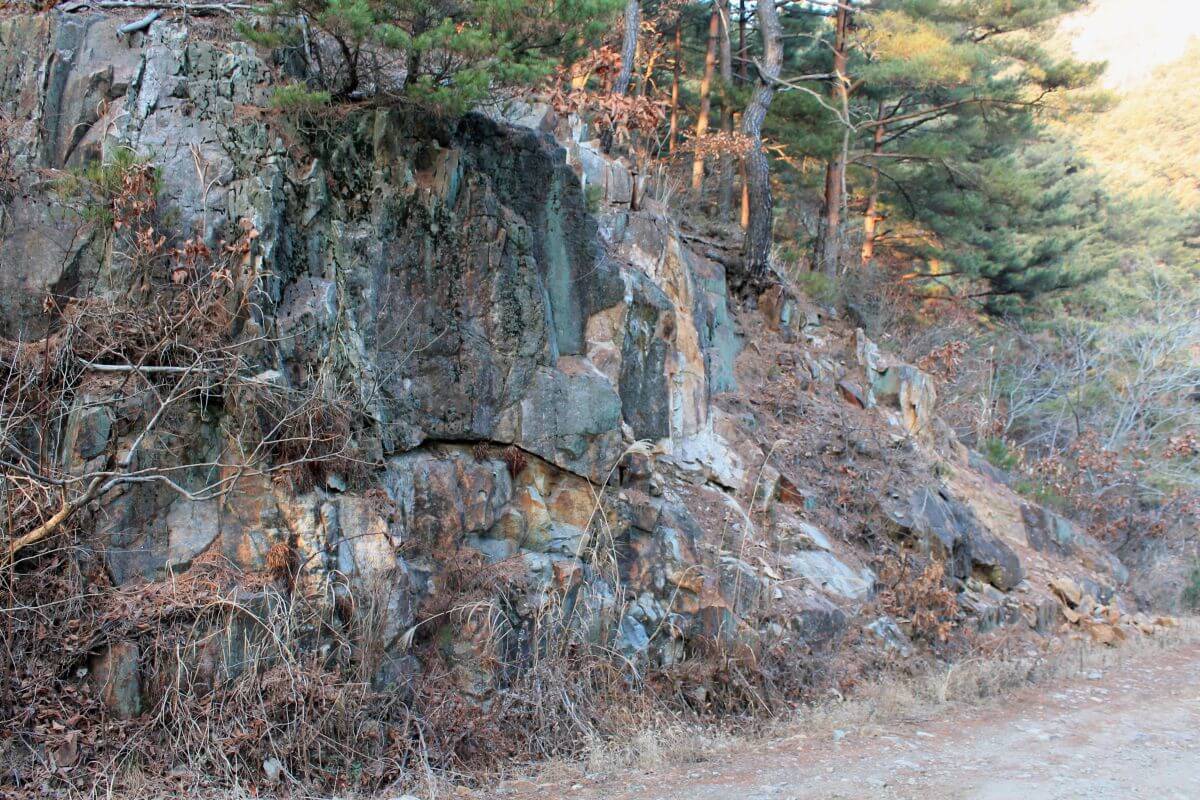
Haman Cu-Au-Ag +/- Co-W Project
The Haman district is situated in the southern coastal region of the Korean peninsula, approximately 300km southeast of Seoul and was the principal copper and cobalt producing region of South Korea up until the end of World War II.
High-grade Cu-Au-Ag ± Co-W sulphide mineralization is associated with veins and sheeted vein stockworks of alkali porphyry copper-gold style and several Exploration Targets have been identified at the Haman group of mines (within a 3km radius).
Historical Mining & Exploration
Most of the production came from the Gunbuk and Haman mines during 1939-1945. Mining activities resumed in 1963 at the Jaeilgunbuk mine until final closure in 1975. Although mining records are incomplete, at least 6,100t of copper metal, 19t of cobalt metal, 41,000oz of gold and 210,000oz of silver were recovered from a minimum 110,000t of hand-worked high-grade ores.
Historical exploration in the Haman district included SP geophysical, soil geochemical surveys and several diamond drilling campaigns, totalling 93 holes for 20,076 metres of narrow AX core. The equivalent of approximately US$30M was expended on these historical exploration and mining activities. Only obvious high-grade sulphide veins were sampled and routinely analysed for Cu. Au and Ag were not analysed in the 1970, 1971, 1975 and 1976 drilling campaigns. The drill logs and adit maps also indicate wide intervals of veinlet and disseminated sulphide mineralization were not sampled at Gunbuk and Oguk. The Jeilgunbuk mine was never drill tested. These sampling practices accord with the country’s traditional narrow vein, underground, hand-worked mining culture.
Geology
The Haman mining district lies in the Jinju Sub-basin of the Gyeongsang Basin, comprising Hayang Group Cycle 2 sequences siltstone, mudstones, evaporite beds and eolian (wind-blown) “red bed” sandstones of the Haman and Jindong Formations. The depositional environment is interpreted as a shallow lacustrine-playa lake setting, with prevailing semi-arid climatic conditions.
A multi-phase sub-alkaline intrusive complex has intruded the Haman and Jindong Formations, displaying a fractionated, evolving trend from early gabbro, then diorite porphyry through to tonalite and more felsic monzonite end-member. The tonalite and monzonite are classified as adakites. Andesitic porphyry (Jusasan Andesite) likely formed a contemporaneous overlying volcanic environment.
Emplacement of the intrusive complex corresponds with the westward-subduction of the Izanagi-Pacific Ridge, resulting in the development of back-arc volcanic belts between 95-85 Ma.
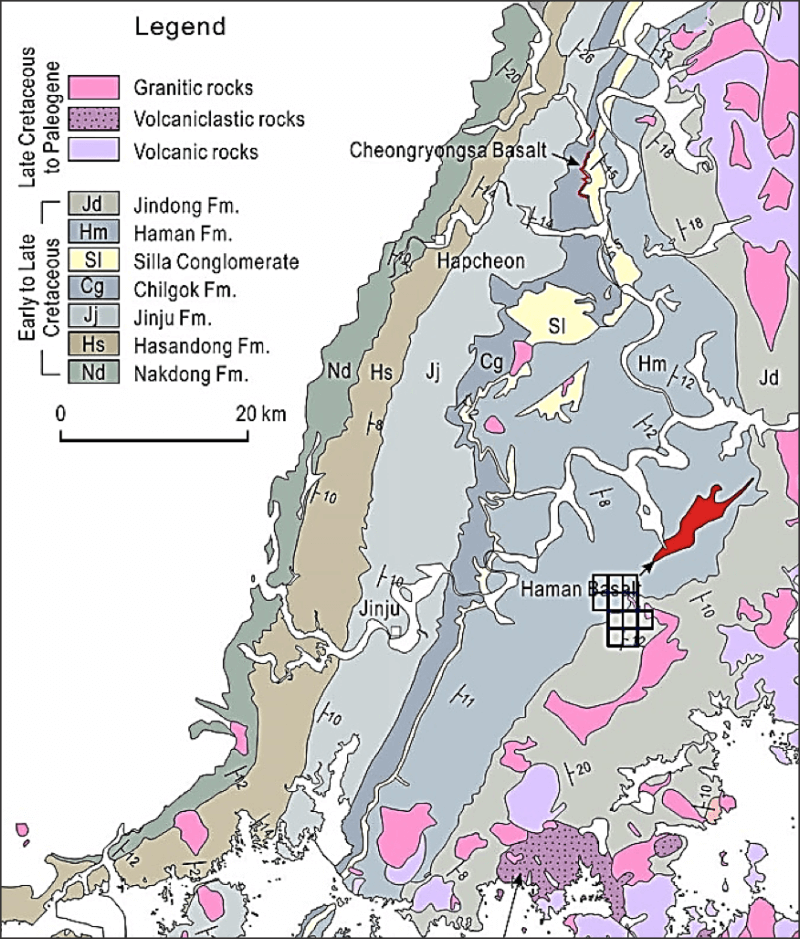
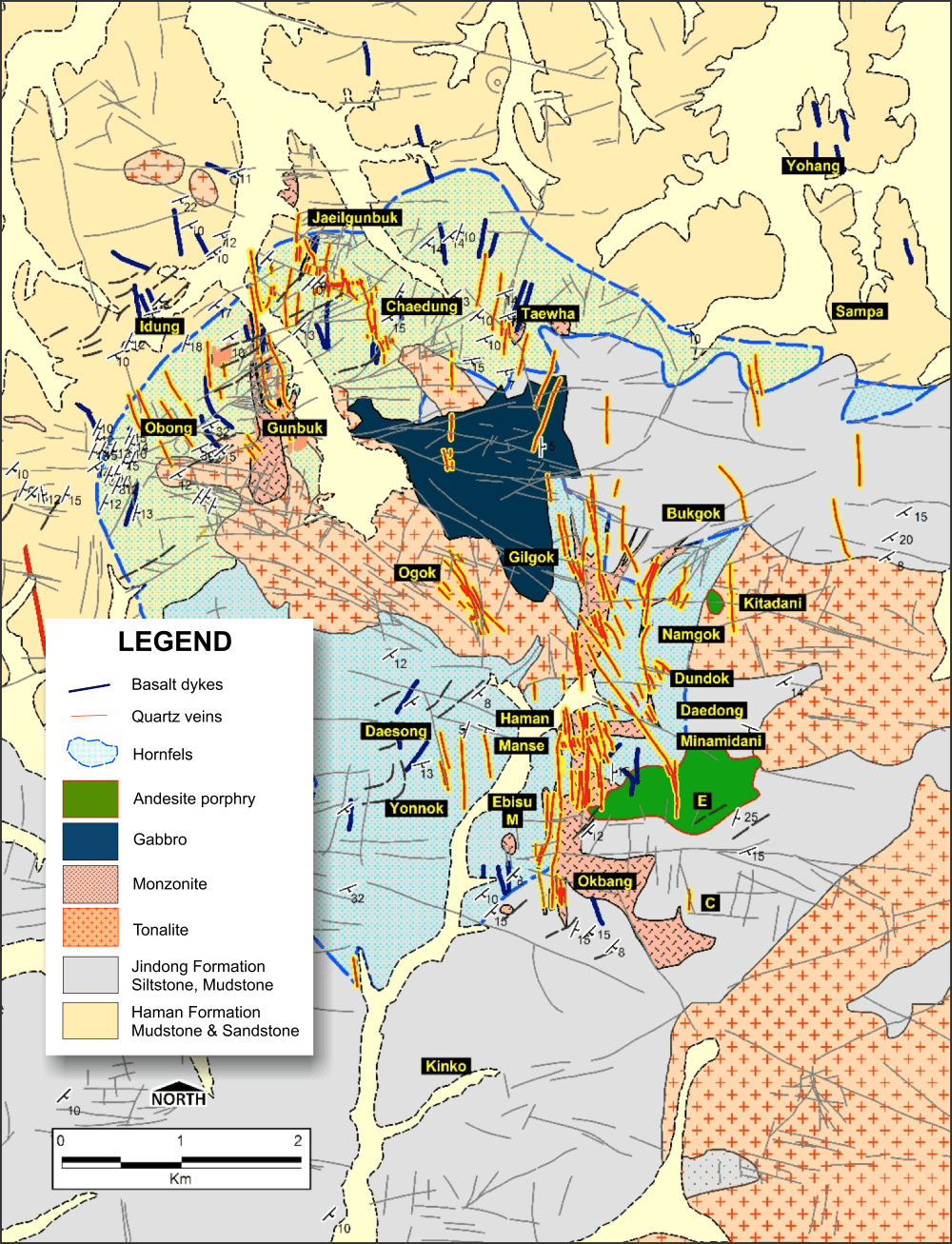
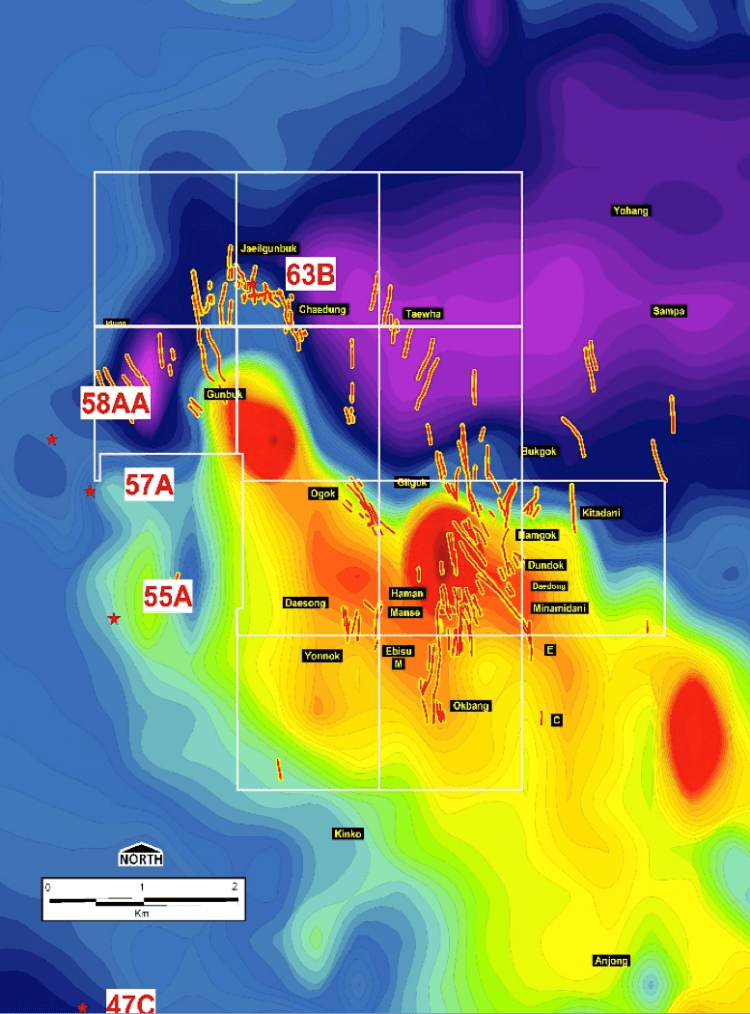
Magnetics Colour Plot
The prominent intense “bullseye” magnetic anomalies of >49,000 gammas correspond to monzonite porphyry intrusions at Gunbuk and Gilgok.
The intense magnetic low anomalies of <-450nT correspond to the Gunbuk and Taewha mines.
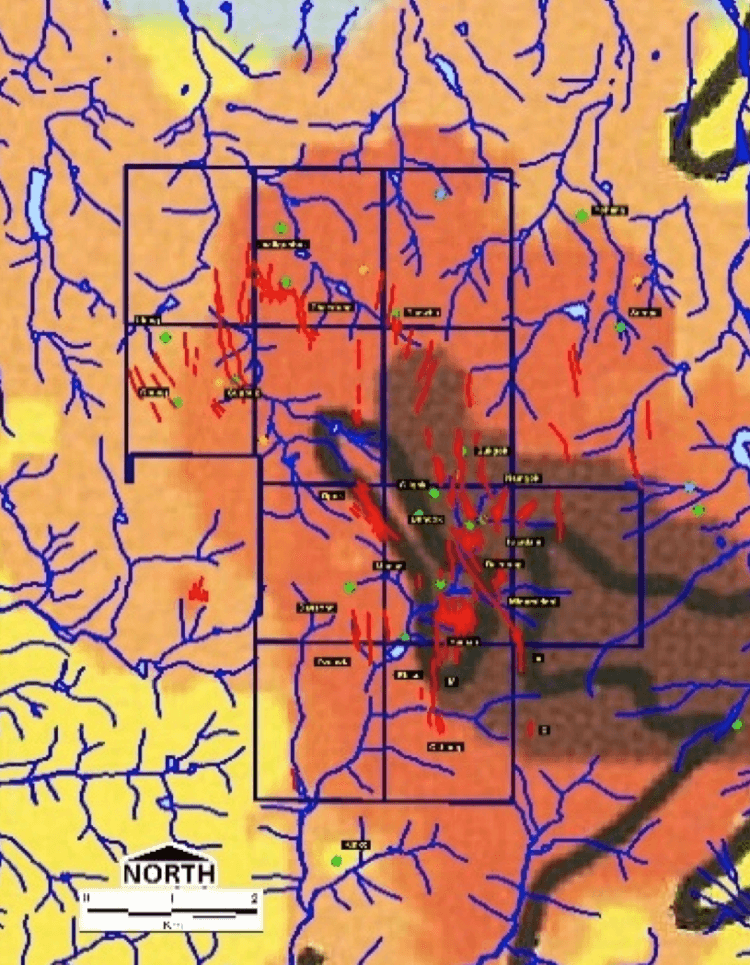
Stream Sediment Geochemistry
There is a very strong coincidental NNW-trending Cu (>122ppm Cu) and Co (>31ppm Co) anomaly present over the Haman Project. The Cu-Co anomaly clearly corresponds to the numerous copper workings and tonalite intrusion.
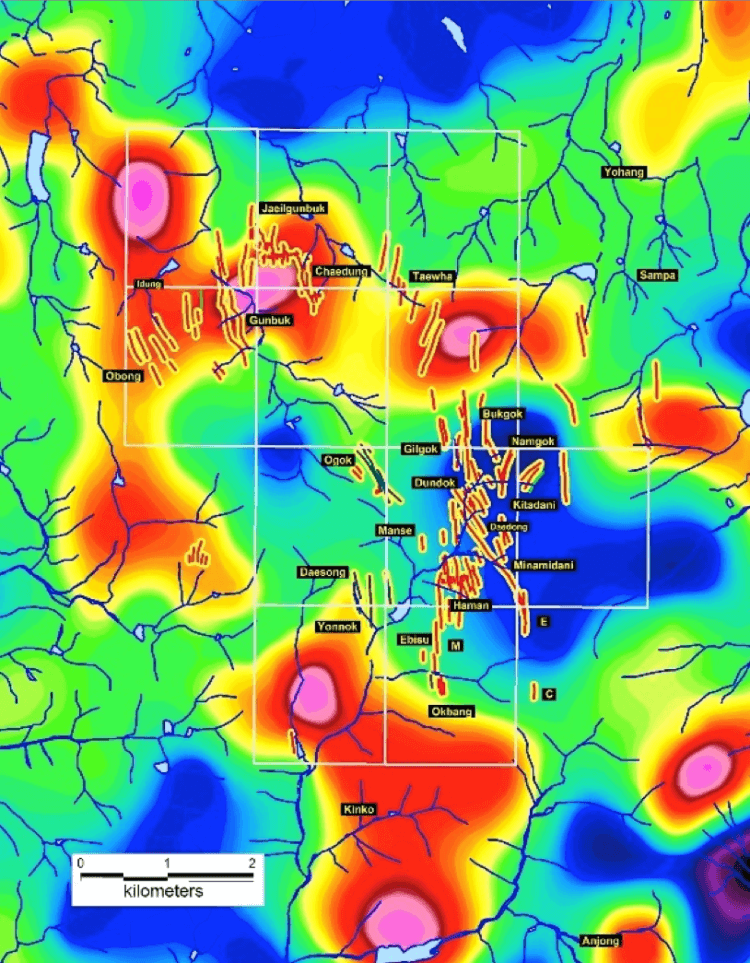
Potassium “K Channel” Colour Plot
“K-channel” radiometric anomalies of >50cps are emphasized and correspond with the Taewha, Jaeilgunbuk and Gunbuk workings.
The “K-channel” anomalies form a “ring of anomalies” around the Haman-Ogok mines corresponding to topographic ridges.
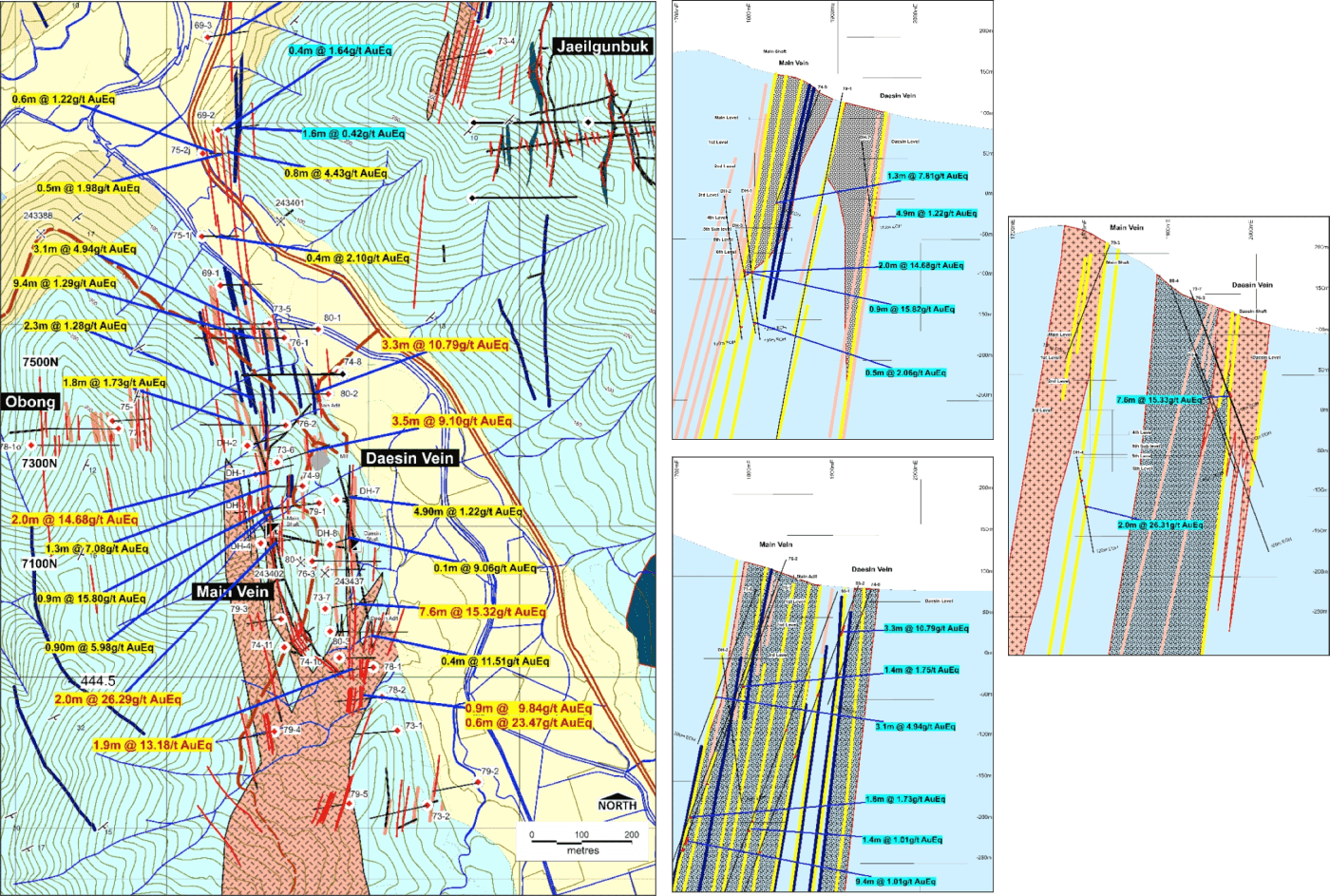
Mineralisation
The Cu-Au-Ag bearing quartz veins of the Haman mining district strike NNW, occurring in a subparallel, en-echelon, sheeted arrangement, mainly dipping steeply to the west. Mineralization consists of fissure-filling, massive or banded comb quartz veins, with a sulphide-rich core. Individual vein widths vary from 1cm – 300cm and display ‘pinch and swell’ characteristics. The veins are probably relay shears, induced by east-west compression, NE extension, and are classified as dilated sheet veins, jogs and tension veins.
Sulphide mineralization consist of chalcopyrite, pyrite and subordinate pyrrhotite and arsenopyrite, with minor scheelite, galena, sphalerite, molybdenite, native bismuth and electrum. Cobalt occurs as cobaltite or as inclusions within arsenopyrite. Silver occurs in electrum, as hessite, or as the Ag-Bi sulphosalt matildite.
Lateral and vertical zonation in vein mineralization, geochemistry and alteration assemblages is recognized, with a Proximal Facies comprising Co with arsenopyrite and tourmaline-magnetite alteration within tonalite, a Middle Facies with better Cu-Au grades associated with tourmaline-magnetite-pyrrhotite-pyrite alteration within hornfelsed sediments around the margins of the tonalite intrusion. Tungsten occurs as scheelite on the margins of this Cu-Au zone. Pyrrhotite and barite content increases away from the tonalite intrusion, forming a Distal Outer Facies.
Copper was transported as a complex chloride brine and deposited at temperatures of 170-550oC, from fluids with salinities of 5.7 to 37.4 wt% NaCl. There is evidence of pH increase and intermittent boiling and the early high-temperature, hypersaline fluid was magmatically derived in proximity to a magmatic source, that subsequently mixed with cooler, more dilute meteoric hydrothermal fluids.
Conceptual Geological Model
The mineralization of the Haman mining district is identified as alkalic porphyry copper gold style hydrothermal-magmatic Cu-Co-Au-Ag mineralization, associated with monzonite ‘pencil’ porphyry intrusions. Quartz-carbonate-magnetite-specularite-tourmaline-sulphide Cu-Au-Ag ± Co-W mineralization is closely associated with two tilted, pencil-shaped, monzonite porphyry intrusions (located at Gunbuk and Gilgok) emplaced into hornfelsed, carbonate-evaporite-bearing siltstones and mudstones of the Cretaceous Haman and Jindong Formations.

Exploration Targets, Haman Project
Mine / Deposit Tonnes
(Million t)Grade Au
(g/t)Grade
Ag (g/t)
Grade
Cu (%)
Ganbuk - Main 1.3-1.8 1.0-1.5 50-70 2.5-3.5
Ganbuk - Daesin 1.0-1.5 2.0-3.0 45-70 2.9-3.5
Oguk 0.4-0.5 6.0-9.0 15-25 4.5-5.0
Gilgok 0.4-0.7 0.6-1.0 5-20 0.5-1.5
Bukgok-Namgok 0.7-1.3 0.2-0.5 5-10 0.3-0.5
M Vein 0.8-1.2 N/A N/A 0.3-0.7
Manse 0.3-0.5 N/A 50-700 1.5-3.0
Ebisu-Haman 0.7-1.0 0.1-1.0 5-30 0.7-1.4
TOTALS 6.0-9.0 1.0-1.5 45-70 1.5-2.5
Notes:
– N/A = No Assay. Gold and Silver were not routinely assayed.
Cautionary Statement: These Exploration Targets were estimated by Senlac Geological Services Pty Ltd (2017) on the basis of historical data quality, sample spacing and continuity of interpreted zones. Due to the use of historical drill data with no documented QA/QC protocols, the deposits have been classified as Exploration Targets under the JORC (2012) Code. There is no certainty that further exploration will result in estimation of Inferred Mineral Resources.
Exploration Targets
The Cu-Au-Ag-Fe ± Bi-Mo-Co-W-Sn mineralization style in the Haman mining district is identified as alkaline porphyry Cu-Au style. Drill-ready Exploration Targets have been identified in the Haman district, including:
- High-grade veins for upgrading to Mineral Resources by close-spaced infill drilling: Gunbuk, Gilgok, M Vein, Manse-Okbang, & Ebisu-Haman.
2. Bulk-tonnage stockwork Cu-Au mineralization associated with the calc-potassic core of monzonite porphyry intrusions:
-
- Monzonite ‘pencil porphyry’ south of Gunbuk.
- Oguk – Sheeted stockwork sulphide-magnetite veins hosted in calc-potassic altered tonalite, with coincidental intense “bullseye” magnetic high anomaly.
- Gilgok – Monzonite ‘pencil’ porphyry, with coincidental magnetic “bullseye” magnetic anomaly, and SP chargeability anomalies.
- Ebisu-Haman – magnetite-tourmaline altered monzonite-tonalite, with coincidental magnetic high “ridge” anomaly, and SP conductivity anomaly.
- Bulk-tonnage sheeted stockworks.
-
- Gunbuk – 800m x 200m zone of veins and sulphide halo.
- Jaeilgunbuk – 960m x 300m zone of veins in a dilatent jog structural setting; coincidental EM conductor and SP chargeability anomalies, never been drill-tested, limited mining.
- Bukguk-Namgok-Dukgok-Kitadani workings – argillic lithocap clay altered sediments intruded by diorite porphyry dykes, coincidental magnetic “ridge” may be monzonite dyke, coincidental K-Channel radiometric anomaly may be phyllic alteration.
- Magnetite-pyroxene skarn.
-
- West of Gilgok, steeply dipping, magnetite-pyroxene-plagioclase skarn is developed on the eastern margin of the gabbro intrusion.
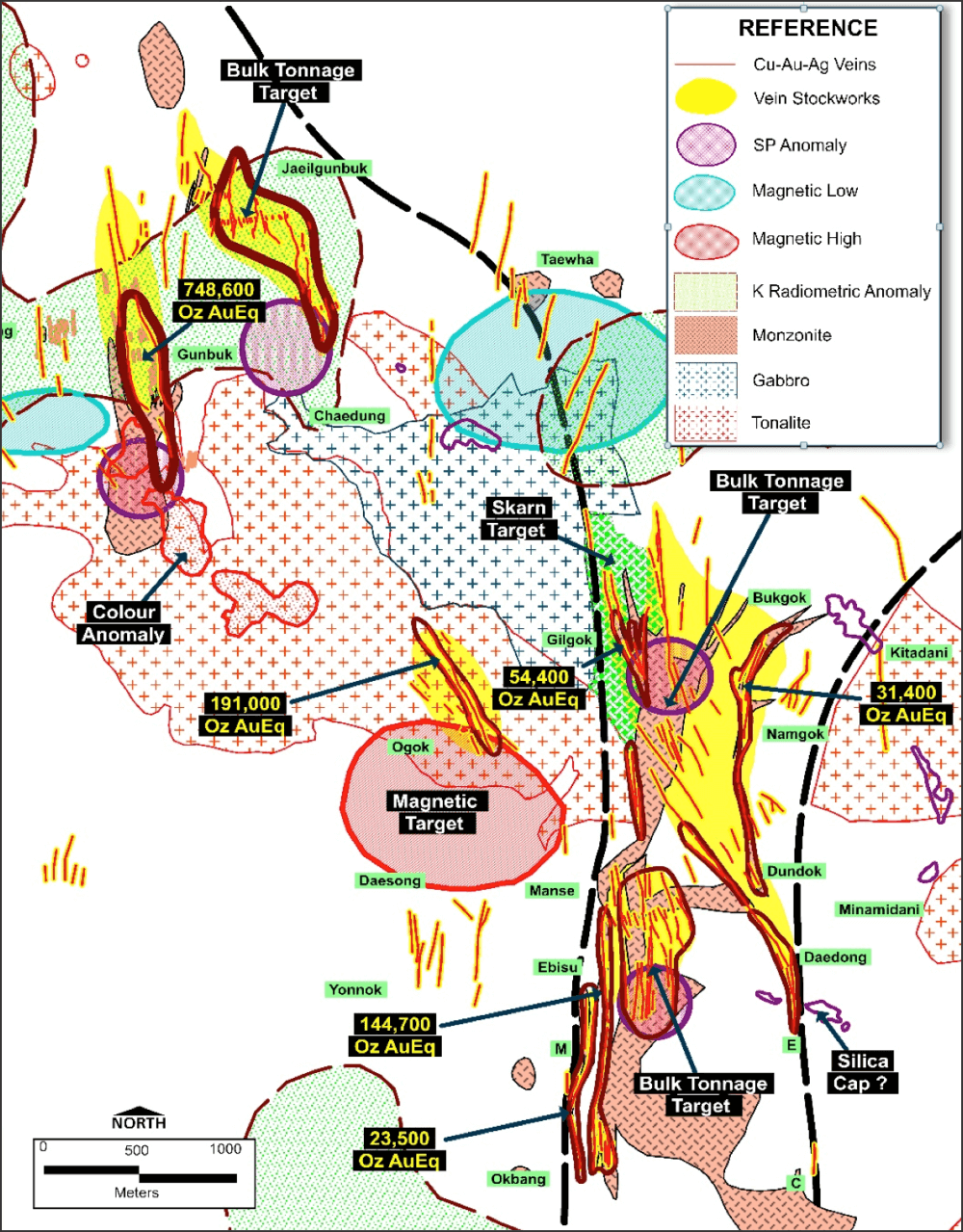
Exploration Target Compilation Map
The vein structures, mine workings, gabbro, tonalite, and monzonite intrusions are indicated, along with the Exploration Targets.
